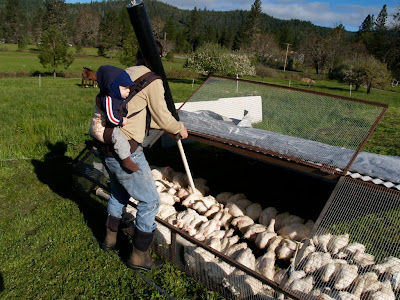Okay, so thank goodness we don't have a feeding frenzy in the most scientific sense of the term (according to Wikipedia, it usually refers to predators, and more specifically, sharks and piranhas, that bite anything that moves (read: "each other") instead of the food that's amply available). But, feed time is definitely the chickens' most exciting time of the day. These photos were taken before we split the batch into two runs, which we did when the chickens were 6 weeks of age (see "Graduating").
Feeding this breed of chicken is a science in itself. The Cornish Cross (or Cornish X, or sometimes called "White Cornish") is bred to eat and produce muscle as quickly and efficiently as possible. They do this well, which is why commercial operations almost always raise the white, Cornish X's. Commercially raised birds are usually butchered at the age of 6 weeks or less because they can just grow so darn fast. This is great if you're a commercial chicken producer, raising them in 12"x12" cages where they don't do anything but eat all day. They're happy to do it, too -- eat all day, that is. They'll plop down in front of the feed trough and never move from there, except to waddle over for a drink, if they even have to move to get that.



Anyway, the point is if you want to free-range or pasture the white Cornish X (as opposed to the Red Cornish, a breed I'll mention again in a bit), you can't offer it "free feed", or have feed constantly available. Instead, you have to ration it to a certain amount per day. If you don't do this, their muscle growth so outpaces their bones, joints and organs, that not only would they never "range" around on the free range, they would start spontaneously dying at about 6 weeks of age anyway from heart or respiratory failure, inability to walk, and a host of other physical problems. They are simply bred (or genetically modified, if you want to think of it this way) to convert feed into muscle, or meat. They are the couch potato of the chicken world. This is why, during our initial research into the whole chicken-raising business, we wanted to raise Red Cornish. Red Cornish are naturally more slow-growing and robust than their white cousins, yet still offer similar quality meat. We didn't end up being able to get the Red Cornish chicks locally, however, so decided to try the rationing on the white Cornish X.
This just brings us back around to the fact, then, that when they are fed, it's a big deal! Before we split the group into two runs, two troughs were just barely enough to get everyone a spot at the feed trough (part of how we knew it was time to split the group into two runs was when they got too crowded at the troughs at feeding time). Milan was feeding three times a day, and the criterion was that the birds had to all be eating all together and finish the ration in 10 minutes.
So, how to fill the trough, when chickens are clucking and bawking and flapping all over, eager for food, became kind of a big issue. It was clear pretty quickly, especially as the birds got larger and larger, that filling the trough by hand was a hassle. To make feeding time easier (and to mitigate a lot of wasted feed), Milan created a special dispenser. A large tube at the top is filled with feed. A valve at the bottom of the large tube flows into a smaller tube. The trough itself is only hung on its ends, so there aren't any obstacles to navigate around to keep the smaller end of the tube in the trough.
Milan actually has to fake the chickens out at one end of the trough and then jump the dispenser tube to the other end to even be able to get the feed into the trough. Of course, Jack is often part of the process. He loves to hang around one side or the other and watch the whole thing.
No comments:
Post a Comment